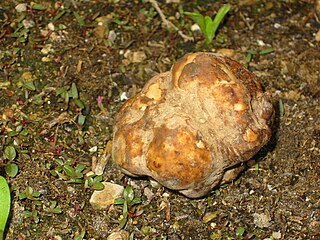
Edible mushrooms are the fleshy and edible fruit bodies of several species of macrofungi. They can appear either below ground (hypogeous) or above ground (epigeous) where they may be picked by hand. Edibility may be defined by criteria that include absence of poisonous effects on humans and desirable taste and aroma.

Euonymus is a genus of flowering plants in the staff vine family, Celastraceae. Common names vary widely among different species and between different English-speaking countries, but include spindle, burning-bush, strawberry-bush, wahoo, wintercreeper, or simply euonymus. It comprises about 130 species of deciduous and evergreen shrubs, small trees and lianas. They are mostly native to East Asia, extending to the Himalayas, and they are also distributed in Europe, Australasia, North America, and Madagascar. 50 species are endemic to China.

A chocolate truffle is a type of chocolate confectionery, traditionally made with a chocolate ganache centre coated in chocolate, cocoa powder or chopped toasted nuts, usually in a spherical, conical, or curved shape.

The Terfeziaceae, or desert truffles, is a family of truffles endemic to arid and semi-arid areas of the Mediterranean Region, North Africa, and the Middle East, where they live in ectomycorrhizal association with Helianthemum species and other ectomycorrhizal plants. This group consists of three genera: Terfezia, Tirmania, and Mattirolomyces. They are a few centimetres across and weigh from 30 to 300 grams (1–10 oz). Desert truffles are often used as a culinary ingredient.

A truffle hog is any domestic pig used for locating and extracting the fruit bodies of the fungi known as truffles from temperate forests in Europe and North America. Pigs have a great sense of smell, and are able to identify truffles from as deep as three feet underground. It is thought that the natural sex hormones of the male pig are similar to the smell of the truffles, and, also, pigs have a natural affinity for rooting in the earth for food. They are trained to hunt truffles by walking on a leash through suitable groves with a keeper.

Craigia is a genus of flowering plants in the family Malvaceae sensu lato or Tiliaceae.
Royoungia is a fungal genus in the family Boletaceae. This is a monotypic genus, represented by the single species Royoungia boletoides, found in Australia.

Aegires is a genus of sea slugs, dorid nudibranchs, marine gastropod mollusks in the family Aegiridae. Species within this genus feed exclusively on calcareous sponges.
Fevansia is a fungal genus in the family Albatrellaceae. A monotypic genus, it contains the single rare truffle-like species Fevansia aurantiaca, found in old-growth forests of Oregon. The name Fevansia honors Frank Evans of the North American Truffling Society, who collected the holotype specimen. Aurantiaca is Latin for "pale orange", referring to the color of the peridium.

The gasteroid fungi are a group of fungi in the Basidiomycota. Species were formerly placed in the obsolete class Gasteromycetes Fr., or the equally obsolete order Gasteromycetales Rea, because they produce spores inside their basidiocarps rather than on an outer surface. However, the class is polyphyletic, as such species—which include puffballs, earthstars, stinkhorns, and false truffles—are not closely related to each other. Because they are often studied as a group, it has been convenient to retain the informal (non-taxonomic) name of "gasteroid fungi".

Geopora cooperi, commonly known as the pine truffle or the fuzzy truffle, is a species of fungus in the family Pyronemataceae. It has a fuzzy brown outer surface and an inner surface of whitish, convoluted folds of tissue. Widely distributed in the Northern Hemisphere, the species has been recorded from Asia, Europe, and North America.
Osmakasaurus is a genus of herbivorous iguanodontian dinosaur. It is a basal iguanodontian which lived during the lower Cretaceous period in what is now Buffalo Gap of South Dakota, United States. It is known from the Chilson Member of the Lakota Formation. This genus was named by Andrew T. McDonald in 2011 and the type species is Osmakasaurus depressus. O. depressus was previously referred to as Camptosaurus depressus, and was first described in 1909 by Charles W. Gilmore.

Gomphidius oregonensis, commonly known as Insidious Gomphidius is a mushroom found only in western North America, most commonly on the Pacific Coast. G. oregonensis can be distinguished by its spores which are the shortest in the genus, typically less than 14 µm long. Earlier in growth, G. oregonensis can be difficult to distinguish from other members of the genus Gomphidius, such as G. glutinosus which is the most common and widespread species. With age, the fruiting body becomes murky and rather insidious in appearance, hence its common name.

Elaphomyces is a genus of hypogeous fungi in the family Elaphomycetaceae. The widespread genus contains 25 truffle-like species. Elaphomyces is one of the most important ectomycorrhizal fungal genera in temperate and subarctic forest ecosystems. E. asperulus, E. granulatus, and E. muricatus were found to accumulate arsenic ; the composition of organoarsenicals is very unusual, with methylarsonic acid and trimethylarsine oxide as major As compounds.

Kalapuya brunnea is a species of truffle in the monotypic fungal genus Kalapuya. The truffle occurs only in the Pacific Northwest region of the United States, in western Oregon and northern California. Known locally as the Oregon brown truffle, it was formerly thought to be an undescribed species of Leucangium until molecular analysis demonstrated that it was distinct from that genus. The truffle is reddish brown with a rough and warty outer skin, while the interior spore-producing gleba is initially whitish before developing greyish-brown mottling as it matures. Mature truffles have an odor resembling garlicky cheese, similar to mature Camembert. The species has been harvested for culinary purposes in Oregon.

Platycerus is a genus of stag beetles (Lucanidae), belonging to the subfamily Lucaninae.














